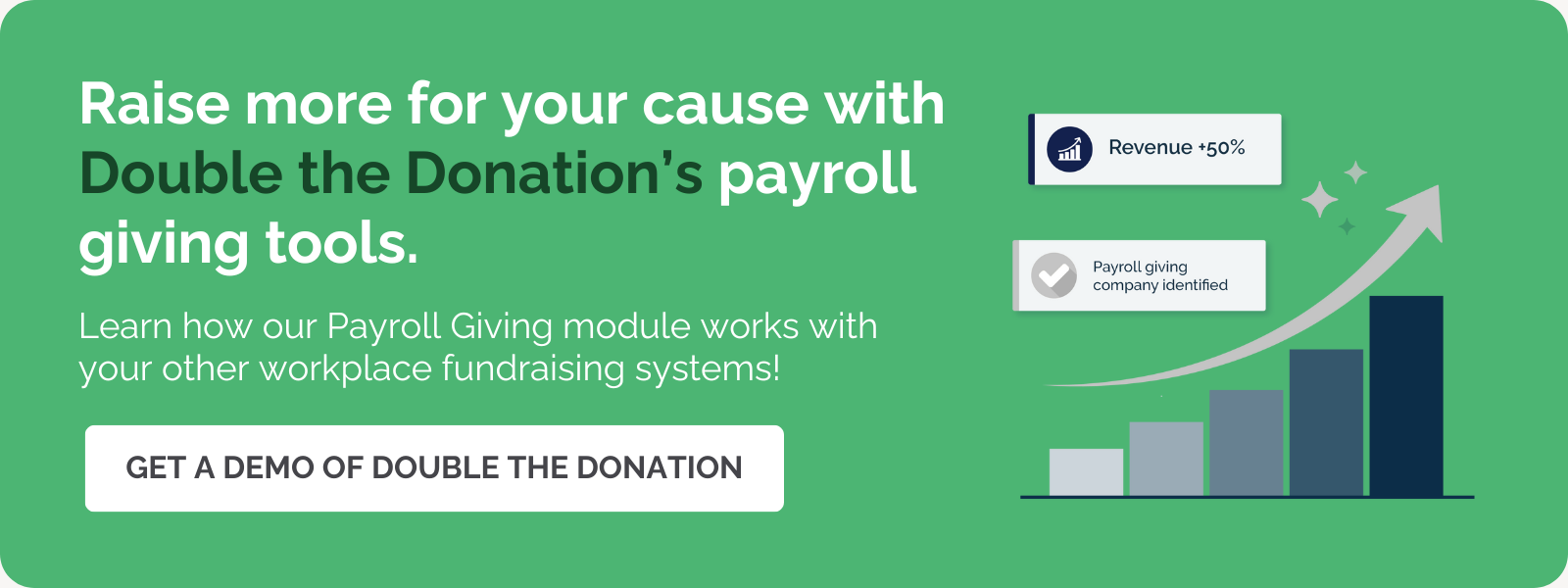8 Key Payroll Giving Metrics to Track at Nonprofits
In the ever-evolving landscape of nonprofit fundraising, understanding the effectiveness of payroll giving programs is crucial. These programs not only facilitate employee donations but also enhance engagement and foster a culture of giving within organizations. To maximize the impact of payroll giving, nonprofits must track specific metrics that provide insights into participation, financial contributions, and overall program success. In this article, we will explore the essential payroll giving metrics that nonprofits should monitor to ensure their programs are thriving.
1. Employee Participation Rate
The employee participation rate is a fundamental payroll giving metric that reflects the percentage of employees engaged in the payroll giving program. A higher participation rate indicates a successful program and greater employee engagement.
As Julia from Double the Donation adds, “Participation rate is the leading indicator of program health, but nonprofits should track it against eligible employees, not just the total workforce. A low rate means your internal promotion is failing, not that the program is unpopular. The goal isn’t just to be registered; it’s to be continuously visible to every single eligible employee throughout the year, especially during open enrollment.”
Understanding Participation Rates
Tracking the participation rate allows nonprofits to gauge the effectiveness of their outreach and engagement strategies. In 2024, payroll giving programs saw a significant increase in participation, highlighting the growing interest in workplace giving initiatives. By analyzing this metric, organizations can identify trends and adjust their strategies accordingly.
Strategies to Increase Participation
- Awareness Campaigns: Regularly communicate the benefits of payroll giving through newsletters, social media, and internal communications.
- Incentives: Consider offering recognition or rewards for employees who participate, fostering a sense of community and commitment.
- Onboarding Programs: Introduce payroll giving during the onboarding process to instill a culture of giving from the start.
2. Average Donation Amount
The average donation amount per employee is another critical metric that helps assess the financial impact of the payroll giving program. This figure provides insights into employee generosity and the overall effectiveness of the program.
Analyzing Donation Trends
In 2024, the average annual employee donation reached $744, with an average company match of $730. Monitoring this metric allows nonprofits to identify patterns in giving and adjust their fundraising strategies accordingly. Understanding the average donation amount can also help organizations set realistic fundraising goals.
Encouraging Higher Donations
- Matching Gifts: Promote employer matching gift programs to encourage employees to increase their contributions.
- Impact Stories: Share stories of how donations make a difference, motivating employees to give more.
- Flexible Giving Options: Allow employees to choose their donation amounts and frequency, making it easier for them to contribute.
3. Total Funds Raised
Total funds raised through payroll giving programs provide a clear picture of the program’s overall success. This metric highlights the cumulative impact of employee contributions and the effectiveness of the program in generating revenue for the nonprofit.
Understanding the Financial Impact
Payroll giving programs collectively raised approximately $5 billion annually, underscoring their significance in the nonprofit sector. By tracking total funds raised, organizations can assess the effectiveness of their payroll giving initiatives and identify areas for improvement.
Strategies to Maximize Funds Raised
- Regular Reporting: Provide updates on fundraising goals and achievements to keep employees informed and engaged.
- Collaborative Campaigns: Partner with other organizations or departments to create joint fundraising initiatives that amplify impact.
- Feedback Mechanisms: Solicit feedback from employees on how to improve the payroll giving program and increase contributions.
4. Employer Matching Rate
The employer matching rate indicates the proportion of employers offering to match employee donations. This metric is essential for understanding the corporate commitment to philanthropy and its impact on employee contributions.
Encouraging Corporate Participation
In 2024, 39% of surveyed companies indicated plans to expand their workplace giving programs, often including matching initiatives. By tracking the employer matching rate, nonprofits can identify potential partnerships and leverage corporate support to enhance their fundraising efforts.
Strategies to Increase Employer Matching
- Awareness Initiatives: Educate employees about matching gift programs and how they can maximize their contributions.
- Corporate Partnerships: Build relationships with companies that have robust matching gift programs to encourage participation.
- Highlighting Impact: Showcase the difference that matching gifts make in achieving organizational goals.
5. Donor Retention Rate
The donor retention rate measures the percentage of employees who continue their contributions over time. High retention rates indicate sustained employee engagement and program effectiveness.
Understanding Retention Challenges
Research shows that 91% of nonprofits stop acknowledging recurring gifts by the third month, which can negatively impact donor retention. By tracking this metric, organizations can identify retention challenges and implement strategies to improve donor loyalty.
As Julia from Double the Donation explains, “Donor retention for payroll giving must be near 100%, yet many nonprofits fail to steward these loyal supporters. The critical error is forgetting they are human donors, not automated transactions. You must proactively counter the ‘set-it-and-forget-it’ pitfall by setting up automated, personalized acknowledgment points, like an anniversary email or a cumulative impact report, to keep the donor emotionally invested in the commitment they’ve already made.”
Strategies to Enhance Retention
- Personalized Communication: Send personalized thank-you notes and updates to acknowledge contributions and demonstrate impact.
- Regular Engagement: Keep donors informed about the organization’s work and how their contributions are making a difference.
- Feedback Opportunities: Provide avenues for donors to share their thoughts and suggestions, fostering a sense of ownership and involvement.
6. Program Growth Rate
The program growth rate reflects the expansion of the payroll giving program in terms of new participants and increased contributions. This metric demonstrates the program’s scalability and the organization’s ability to attract and retain donors.
Tracking Growth Trends
In 2024, 39% of surveyed companies indicated plans to expand their workplace giving programs, reflecting a growing trend in corporate philanthropy. By monitoring the program growth rate, nonprofits can assess the effectiveness of their outreach efforts and identify opportunities for expansion.
Strategies to Foster Growth
- Targeted Outreach: Identify and engage potential participants through targeted communication strategies.
- Partnership Development: Collaborate with other organizations to expand reach and attract new donors.
- Continuous Improvement: Regularly evaluate and refine the payroll giving program to enhance its appeal and effectiveness.
7. Impact Reporting and Transparency
Impact reporting and transparency refer to the clarity and frequency with which the nonprofit communicates the outcomes of the payroll giving program. This metric builds trust and encourages continued participation.
Importance of Transparency
Companies like PwC have successfully addressed employee participation barriers by implementing “opt-out” models for new hires and providing transparent impact reporting. By tracking this metric, nonprofits can enhance their credibility and foster a culture of giving.
Strategies for Effective Reporting
- Regular Updates: Share regular updates on the impact of payroll giving contributions through newsletters and social media.
- Visual Storytelling: Use infographics and videos to illustrate the impact of donations and engage employees.
- Feedback Loops: Encourage employees to provide feedback on impact reporting to ensure it meets their needs and expectations.
8. Administrative Efficiency
The last of our payroll giving metrics to track has to do with administrative efficiency. Administrative efficiency measures the effectiveness of the systems and processes in place to manage the payroll giving program. This metric ensures smooth operation and minimizes errors or delays in processing donations.
Enhancing Operational Efficiency
Modern cloud-based platforms have dramatically simplified payroll giving processes, requiring minimal intervention from internal teams. By tracking administrative efficiency, nonprofits can identify areas for improvement and streamline their operations.
Strategies to Improve Efficiency
- Technology Integration: Utilize technology solutions to automate donation processing and reporting.
- Training and Support: Provide training for staff to ensure they are equipped to manage the payroll giving program effectively.
- Regular Audits: Conduct regular audits of the payroll giving program to identify inefficiencies and implement improvements.
Frequently Asked Questions (FAQ)
1. Why is tracking payroll giving metrics important for nonprofits?
Tracking payroll giving metrics helps nonprofits measure program performance, identify trends, and make informed decisions. Metrics such as participation rate, average donation amount, and donor retention reveal how effectively the program engages supporters and drives revenue.
2. What is the employee participation rate in payroll giving?
Employee participation rate reflects the percentage of eligible employees who actively contribute through payroll giving. A higher rate indicates stronger engagement, successful outreach, and effective promotion of recurring workplace giving opportunities.
3. How can nonprofits improve donor retention within payroll giving programs?
Nonprofits can improve retention by sending personalized thank-you messages, regularly sharing impact updates, celebrating giving milestones, and maintaining ongoing communication. Consistent stewardship helps donors feel valued and committed to long-term support.
4. What are the key benefits of payroll giving for nonprofits?
Payroll giving provides nonprofits with predictable, recurring revenue and strengthens donor loyalty. It also reduces administrative burdens by automating donations and creates opportunities to engage donors with matching gifts or volunteer programs offered by their employers.
5. Why do donors prefer payroll giving as a way to support nonprofits?
Donors appreciate payroll giving because it’s convenient, automatic, and budget-friendly. Contributions are deducted directly from their paychecks, making giving effortless—especially when employers also offer matching gifts to increase the impact of each donation.
Conclusion
Tracking payroll giving metrics is crucial for nonprofits aiming to optimize the impact of their fundraising efforts. By monitoring employee participation rates, average donation amounts, total funds raised, employer matching rates, donor retention rates, program growth rates, impact reporting, and administrative efficiency, organizations can gain valuable insights into their payroll giving programs. Implementing strategies to enhance these metrics will not only improve fundraising outcomes but also foster a culture of giving within the organization. As the landscape of corporate philanthropy continues to evolve, nonprofits must remain proactive in leveraging payroll giving to achieve their missions.
Enhance Your Payroll Giving Strategy with Double the Donation
Ready to take your nonprofit’s payroll giving program to the next level? Double the Donation’s Payroll Giving Module is your key to unlocking sustained corporate support. With our comprehensive tools, you can effortlessly identify eligible donors, guide them through the donation process, and capitalize on multiple revenue opportunities. Our user-friendly website plugin, insightful dashboards, and ready-to-use marketing materials are designed to streamline your efforts and drive recurring donations.
Don’t miss out on the potential of payroll giving. Learn how you can grow payroll giving revenue with Double the Donation. Request a personalized demo today!





